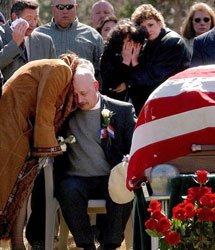________________________________________________
This news article by staff writer
Michelle Krupa of the
Times-Picayune was published in yesterday's edition of the newspaper....
_________________________________________________
President Bush toured New Orleans' most flood-ravaged neighborhood for the first time Wednesday morning, strolling down a street of rotting homes and using the visit to call on Congress to honor his proposal to earmark an additional $4.2 billion for Louisiana housing recovery.
Standing atop the breached Industrial Canal levee in the Lower 9th Ward, Bush said he is counting on lawmakers to reverse a Tuesday move by leaders of the House Appropriations Committee that would let other states, including Bush's home state of Texas, vie for the cash. The money is part of a $92 billion supplemental spending request Bush proposed last month, including $19.8 billion for Gulf Coast recovery aid
"Congress needs to make sure that the $4.2 billion that I requested goes to Louisiana," said Bush, who was joined by his wife Laura, Gov. Kathleen Blanco, Mayor Ray Nagin, Gulf Coast recovery coordinator Donald Powell and a bevy of Army Corps of Engineers personnel.
The trip Wednesday was the president's ninth visit to south Louisiana since Hurricanes Katrina and Rita ravaged communities from St. Bernard Parish to Lake Charles last fall. It included a nearly 2 ½-hour tour of the Lower 9th Ward, with stops at a debris heap on North Rampart Street and a diner off Desire Street.
The visit came on the heels of three recent federal reports that criticize the government's response to Katrina, as well as previously unreleased video that showed Bush was warned the day before Katrina hit that New Orleans levees might fail.
Bush, however, said he made the trip at the request of Nagin and Blanco. "The mayor and the governor thought it was important for me to see firsthand the devastation," he said.
$4.2 billion defendedDefending his request for $4.2 billion to be spent solely in Louisiana, Bush said the figure matches the amount required to launch a state housing rehabilitation plan that would offer payouts and rebuilding grants of as much as $150,000 apiece for almost 169,000 flooded Louisiana homes. He said that blueprint likely would win approval on a "timely basis" from the U.S. Department of Housing and Urban Development, which has reviewed the preliminary plan.
Some congressional and administration officials have blamed the state's lag in generating its own housing plan for the delay in Louisiana's storm recovery. But Bush seemed to strike a conciliatory note Wednesday, calling the state's buyout proposal "a well-thought-out plan that has been put together by the local folks."
"The housing plan has been coordinated by state authorities with local authorities, as well as with (federal housing) authorities. In other words, we've all been working together to figure out how to come up with a housing plan that will restore the confidence of the people of this important part of our country."
Bush also rebuked Congress for stripping out of a $29 billion hurricane recovery spending package approved in December his requests for money to armor levees, add new pumping stations near Lake Pontchartrain and close off canals that failed and flooded much of the city after Katrina. Bush's current request includes $1.5 billion for that work.
"Congress heard our message about improving the levees, but they short-changed the process by about $1.5 billion," he said. "And so, in order to help fulfill our promise on the levees, Congress needs to restore" the money.
Capitol Hill aides have said Congress is unlikely to vote on the spending package, the fourth since the storm, before May. The first three packages totaled about $68 billion.
'A fine job'At the Industrial Canal levee breach, Bush saw diagrams of the new levee and floodwall design being implemented there, along with photographs snapped soon after the 13-foot floodwall crumbled during the Aug. 29 storm. The shots showed the scene just outside the levee, now a disaster of dry wreckage, at the time it was inundated.
Col. Lewis Setliff, the coordinator of the corps' Task Force Guardian in charge of rebuilding the levees, told Bush that since beginning work in December, the corps has restored 44 percent of storm-wrecked levees to their pre-Katrina strength or better. The agency has promised to restore flood protection to pre-Katrina levels by June 1, the start of hurricane season.
"You've done a fine job," Bush told corps personnel, putting his arms around several workers to pose for a snapshot. He said later: "We fully understand that if people don't have confidence in the levees, they're not going to come back."
Also speaking at the levee breach, Laura Bush announced The Gulf Coast School Library Recovery Initiative, a project of her charity foundation that aims to restore the libraries of 1,121 public and private schools damaged or destroyed by Katrina, Rita and Hurricane Wilma, which struck Florida in October. Organizers hope to raise $5 million in private and corporate donations to support the effort, a foundation spokesman said.
Walking amid debrisThe president arrived at Louis Armstrong International Airport at 8:30 a.m., about a week after a bipartisan delegation of congressional leaders began its own three-day tour of the region. Bush boarded a helicopter bound for the Port of New Orleans' France Road terminal. By motorcade, he crossed the St. Claude Avenue bridge, then hung a right onto Lamanche Street and stopped at the corner of North Rampart Street for about 20 minutes.
In perhaps his most intimate view of the damage wrought in New Orleans by Katrina, Bush stepped out of his SUV and approached a debris heap of the kind that has remained a common sight on city streets: a mass piled several feet high with couch cushions, a child's sneakers, moldy clothing, an oatmeal can, a bed frame, several television sets and a mattress, all set next to a flooded-out Chevrolet Cavalier.
Houses lining the street bore the telltale signs of the hurricane. "Dead dog" was spray-painted on the outside wall of a brick home. An X painted on another house showed that it had been searched by rescue workers on Sept. 11, with no one found inside.
Wandering away from the entourage, Nagin peered into the wide-open front door of a house cleared of much debris but not gutted since the storm.
"Mr. President! You ought to come see this," the mayor called to Bush, who stepped onto the porch and gazed into the dim space. Neither of them entered.
Outside, Laura Bush peppered Gil Jamieson, FEMA's deputy director of Gulf Coast recovery, with questions. "Is this debris out of one house?" she asked, pointing to the pile. "It was just put out on the street? What about the homeowners who are gone?"
Sharing thoughtsThe motorcade then headed down Caffin Avenue toward the Industrial Canal, speeding through the mostly desolate neighborhood. Construction workers in hard hats lined some blocks, along with onlookers waving disposable cameras. A handful of demonstrators held a homemade placard that read "Where's My Government?" while another group shouted, "Stop evictions now!"
Before returning to the port facility and lifting off by helicopter for an afternoon tour of coastal Mississippi, the president grabbed a to-go container of red beans and rice at Stewart's Diner, a short-order restaurant at North Claiborne Avenue and Desire Street.
Bush, Laura Bush, Blanco and Nagin spent about 10 minutes at the lunch counter chatting with owner Kim Stewart and some of her relatives, then emerged with Stewart, who invited the president to give her a call with his comments on the meal.
"Give me a little feedback on it," she said.





















